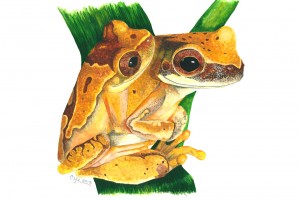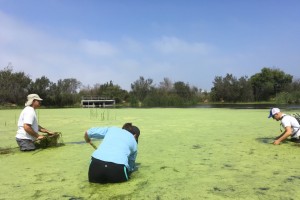Geeks for Geckos: HerpFest at CSUN Showcases SoCal’s Reptile and Amphibian Research
To her parents’ chagrin, Jessica Yamauchi grew up a lizard catcher.
“I had parents that were afraid of these animals and didn’t want them anywhere near the house,” said Yamauchi ’19 (biology). “I would always walk by the windows like, ‘I got one — I got another lizard!’ and they were like, ‘That’s great; don’t bring it inside.’”
At CSUN, Yamauchi went to much greater lengths to catch reptiles and amphibians — wading through murky wetlands to net American bullfrogs at various stages of their lives. CSUN also provided kindred spirits and a much more receptive audience: On May 19, she presented her research at a regional gathering of herpetologists, known as HerpFest.

Cynthia J. Hitchcock, a lecturer in CSUN Department of Biology, sold herpetology-themed paintings at the 2019 HerpFest.
Herpetologists study amphibians (frogs, toads, salamanders, newts, etc.) and reptiles (snakes, lizards, turtles, alligators, crocodiles, etc.). Technically, birds are also reptiles — representing an evolutionary branch of feathered dinosaurs — but they’re traditionally studied by ornithologists.
HerpFest is an annual event hosted and run by volunteers. The event took place at CSUN for the first time, organized by biology professor Robert Espinoza and co-hosted by UCLA biology professor H. Bradley Shaffer. Espinoza volunteered CSUN’s Chaparral Hall as a venue after UCLA lost the main building of its La Kretz Center in the November 2018 Woolsey Fire. Attendance and presenters were split fairly evenly between students and researchers from institutions such as UCLA, UC Santa Barbara, Cal Poly San Luis Obispo and the U.S. Geological Survey.
Not Warm and Fuzzy
HerpFest students and researchers bond over their under-appreciated specialty. Reptiles and amphibians aren’t furry or cute in the traditional sense, so even other animal researchers sometimes don’t appreciate how interesting these creatures can be. (Well, the scientists who study spiders probably understand, Yamauchi said.)
But the implications of herpetological research can be global. So-called “cold-blooded” creatures may be more susceptible to the whims of a rapidly changing climate. Moreover, if researchers can understand why some invasive reptile and amphibian species can settle in new places and succeed, they might be able to stop those that damage local ecosystems.
“Other research might not be as broad, but it’s the kind of basic research scientists want to do to understand how the world works,” Espinoza said.
Biodiversity Hot Spot
HerpFest showcased Southern California as a biodiversity hot spot, with more than 100 reptile and amphibian species supported by fairly mild coastal climates as well as desert extremes.
Some of these species live in SoCal and nowhere else, such as Southwestern pond turtles, which live in freshwater streams and creeks, and coastal horned lizards, which live on coastal mountains — both of which have been dramatically displaced because people like to convert their habitats into homes, golf courses and other developments.
CSUN Research
Many of the researchers at HerpFest also conduct field work in deserts, along coasts and in rainforests across the world. CSUN biology professor Jeanne Robertson gave an overview of the wide-ranging evolutionary research she and her students are conducting at CSUN, including locales as close as the Channel Islands and as far away as Argentina.
CSUN student Matt Dickson is studying the adaptability of the Mediterranean house gecko, which can be observed picking off bugs on porch lights throughout California and 23 other states, in climates ranging from the Death Valley heat to decidedly cooler parts of the country like Pennsylvania and New Jersey.
Meaghan Clark, who defended her master’s thesis in biology and completed her graduate degree at CSUN just before HerpFest, was interested in the unusual color pattern of nocturnal red-eyed tree frogs. These frogs, which live in Mexico, Central America and South America, aren’t considered toxic but have bright orange feet and blue-and-yellow flanks, colorations that typically serve as a signal to predators that animals are toxic — or at least unpalatable (example: poison dart frogs are colored like 1980s workout spandex).
Clark wondered: Could these colors mean tree frogs taste terrible? Her research measured their “tastiness” to other creatures.
She gave fruit flies borrowed from CSUN biology professor Mariano Loza-Coll access to two differently colored solutions, one that included the frogs’ skin peptides, as well as a control solution with no peptides. The stomachs of fruit flies are translucent, so the differing food coloring revealed which solution they preferred, unlocking another of the world’s mysteries.
“We learned red-eyed tree frogs do indeed taste bad,” Clark said. “I don’t recommend eating them. It supports the hypothesis that if you’re a predator, you might also avoid eating them.”
Metamorphosis

CSUN biology professor Robert Espinoza, and students Jessica Yamauchi and Dillon Monroe, search the Ballona Wetlands for specimens of the American bullfrog. Photo courtesy of Jessica Yamauchi.
Yamauchi presented findings on changes in the gut microbiome — the ecosystem of microbes that live in intestines of animals — that occur when American bullfrogs transform from tadpoles into adults. This is a dramatic change, as tadpoles eat algae before their stomachs and mouths physically transform to accommodate carnivorous meals — insects, birds and even other frogs. Yamauchi collected tadpoles and bullfrogs in the Ballona Wetlands in Playa del Rey, north of Los Angeles International Airport.
Yamauchi, who plans to be a veterinary researcher focused on conservation medicine, said her research could have implications for humans, who undergo similar changes in diet, going from breast milk or formula to omnivorous diets.
“I told Dr. Espinoza when I joined his lab, ‘This is exactly what I would love to do, and I want to explore the field more,’” she said.




 experience
experience